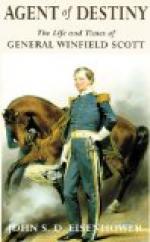[Illustration: Note.—The accompanying map indicates the movements of the troops in the battle of Chippewa. A H show the position of Majors McNeil and Leavenworth when they made the final charge. a, a, a, the point to which General Porter drove the British and Indians. b, Street’s barn.]
A fort called Messasauga was built after the campaign of 1813 by the British as a defense to Fort George, and being re-enforced by General Riall, he moved to Burlington Heights on Lake Ontario. It was General Brown’s intention to capture these forts before beginning further or more extended operations. With this purpose, he ordered some heavy guns from Sackett’s Harbor; but Commodore Chauncey being sick, and the enemy having a superior fleet on the lake, the attack on these forts was abandoned. General Brown then made a feint by moving up the Niagara and recrossing the Chippewa, with a view to draw the enemy down and to enable him to obtain supplies from Fort Schlosser. Failing in this, it was his purpose to send General Scott by the road from Queenstown and thus force Riall to battle.
On the afternoon of the 25th General Brown received a note from a militia officer who occupied some posts on the American side of the Niagara, that a thousand British troops had crossed from Queenstown to Lewiston, a few miles below the Chippewa. It was thought that the object of this movement was to capture the American magazines at Schlosser and cut off supplies from Buffalo. General Brown having determined to threaten the forts at the mouth of the Niagara, General Scott’s command was put in motion for this purpose. It consisted of four battalions under Colonel Hugh Brady, and the commands of Majors Jesup, Leavenworth, and McNeil, Captain Towson’s artillery, and Captain Harris’s detachment of cavalry, the whole force aggregating thirteen hundred men. After a march of two miles some mounted British officers were discovered on a reconnoitering expedition, their forces being a short distance off and hidden from view.
General Scott’s orders were to march on the forts, as information had been received that Riall had divided his forces, sending a thousand of them across the river. He, however, determined to move forward and give battle. Dispatching Adjutant-General Jones to General Brown with information that the enemy was in his front, he moved on, and was astonished to see drawn up in line of battle on Lundy’s




